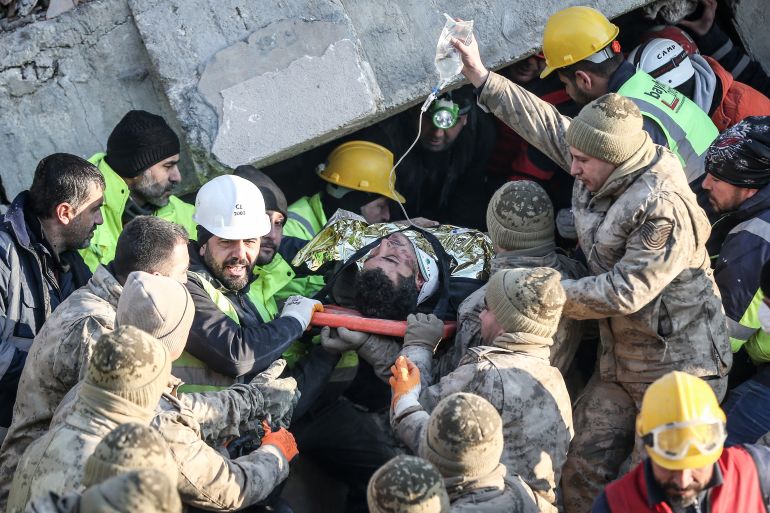Turkey-Syria earthquakes day five: What do we know so far?
Hope of finding survivors is dwindling as the death toll tops 21,500 in Turkey and Syria.

Rescue workers are digging into the rubble for a fifth consecutive day to find more survivors of the devastating earthquakes that have killed tens of thousands of people and swept away entire cities in Turkey and Syria this week.
Operations continued on Friday, but hopes of finding people alive are fading away.
Keep reading
list of 3 itemsChristian Atsu pulled alive from Turkey quake rubble: Report
Turkey declares 3-month emergency in 10 quake-hit provinces
“This collapsed building has been a graveyard,” said Al Jazeera’s Resul Serdar, reporting from Kahramanmaras, a Turkish city close to the epicentre of Monday’s magnitude 7.8 earthquake. A second magnitude 7.6 quake followed a few hours later amid hundreds of aftershocks. “Dozens of people have been taken out [of the rubble], but all were dead,” Serdar said.
Still, there is room for some hope amid the devastation. An 18-month-old baby and her family members were pulled alive from beneath the ruins of a collapsed building in Hatay’s Antakya district in southern Turkey, after being trapped for 96 hours, the Anadolu Agency reported.
Here is a roundup of what you need to know on day five of the rescue effort:
What do we know about the casualties?
The death toll from the Turkey-Syria earthquakes, which Turkish President Recep Tayyip Erdogan has called “the disaster of the century”, has passed 21,500.
At least 18,342 people have been killed in Turkey, according to Vice President Fuat Oktay, while at least 3,377 are known to have died in Syria.
By comparison, 18,400 died in the 2011 earthquake off Fukushima, Japan, which triggered a tsunami and an estimated 18,000 people died in a quake that hit Izmit, Turkey, in 1999.
Tens of thousands were also injured in Monday’s disaster and many tens of thousands have been left homeless.
What do we know about the rescue operations?
The winter weather and damage to roads and airports have hampered the rescue response. Some in Turkey have complained that the government was slow to respond – a perception that could hurt Erdogan at a time when he faces a tough battle for re-election in May.
The president has been visiting affected cities over the last two days.
Turkey’s disaster management agency said more than 110,000 rescue personnel would be taking part in the effort with the assistance of more than 5,500 vehicles, including tractors, cranes, bulldozers and excavators. The foreign ministry said 95 countries have offered help.
Even though experts say trapped people could survive for a week or more, the chances of finding survivors in the freezing temperatures are dimming, with emergency crews now starting to shift the focus to demolishing dangerously unstable structures.
In Kahramanmaras, a sports hall the size of a basketball court was serving as a makeshift morgue to accommodate and identify bodies.
In the Turkish city of Antakya, dozens scrambled for aid in front of a truck distributing children’s coats and other supplies. One survivor, Ahmet Tokgoz, called for the government to evacuate people from the region.
Many of those who have lost their homes found shelter in tents, stadiums and other temporary accommodation, but others have slept outdoors.
International aid
The United States on Thursday announced an initial $85m package in emergency relief for the two affected countries, and is also temporarily lifting some of its Syria-related sanctions, hoping to help aid move as quickly as possible to those affected.
Meanwhile, the World Bank has announced $1.78bn in aid to Turkey to help with relief and recovery efforts.
United Nations chief Antonio Guterres is calling on the international community to provide more money for Turkey and Syria, and widen access for aid to reach the earthquake-stricken parts of Syria.
Humanitarian aid to northwestern Syria
Providing aid to opposition-controlled areas in northwestern Syria has proven highly problematic.
Residents of Jindires, one of Syria’s worst-affected areas, are left using their hands to search for survivors beneath collapsed buildings and are pleading for international help after the deadly earthquakes.
A first convoy of six trucks managed to get through the Bab al-Hawa crossing – the sole crossroad approved by the UN – on Thursday, but it provided little relief.
The US Agency for International Development said in a statement that the funding will go to partners on the ground “to deliver urgently needed aid for millions of people”, including food, shelter and emergency health services.
Piling tragedies
The earthquake has brought misery of another kind to people in Syria’s Idlib province where a dam collapse caused a river to overflow its banks and flood homes, according to Al Jazeera’s Sohaib al-Khalaf.
The earthquake and the floodwaters from the Asi River (also known as the Orontes River) destroyed more than 20 houses in al-Tlul village and inundated many others, according to al-Khalaf.